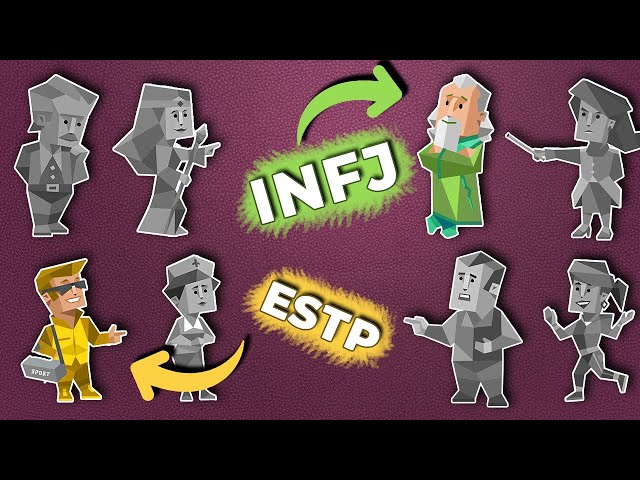MBTI 16 Personalities – How to Spot Them?
Welcome to Psychology Refresh! Today, we’re diving into How to Spot Each MBTI Personality Type Instantly. Make sure to read through each section, and you’ll be able to identify people’s personality types in just a few seconds!
Each personality type exhibits unique body language and communicates in a distinct way. We’ve outlined their behavior and communication styles for all 16 personality types. Discover these traits and learn how to use this knowledge for personal growth and self-improvement. Here’s How to Spot Each MBTI Personality Type Instantly:
1. ISTJ
ISTJs deliberate before speaking. You’ll notice they think silently before responding, focusing on ensuring their words are logical and truthful. Their communication is highly sequential, making their thought process easy to follow. They use comparative terms like “looks like” and provide precise information, often drawing on past experiences to support their claims. An ISTJ’s primary goal when speaking is to convey information and experiences without exaggeration or excessive physical movement. They don’t seek to command attention and may appear enigmatic. Since their emotions are experienced inwardly, they use minimal facial expressions or body language, coming across as stoic. Even when they have strong feelings, ISTJs keep most emotions private, which can make them seem reserved. They feel awkward discussing feelings, especially when unprepared, and being pressured to give an emotional response causes them stress.
2. ISFJ
ISFJs pause to consider their words before speaking. They need time to process information and their own views before responding, disliking being rushed. Their speech is linear and chronologically ordered, with straightforward delivery and plenty of specifics and examples to clarify their thoughts. ISFJs aim to share helpful knowledge, often identifying with their audience by saying things like, “I feel that way.” They respond with smiles and politeness, prioritizing making others feel understood. However, they take criticism personally and become anxious in hostile or argumentative settings.
3. ESTJ
ESTJs process thoughts aloud, often sounding like they’re asserting facts when they’re merely exploring ideas. They enjoy hearing others’ reactions to their views, as it helps them reach conclusions. When alone, they may talk to themselves. Their speech is accurate, realistic, and confident, with a strong memory for details. They compare the present to the past to assess reliability and prefer logical topic transitions. ESTJs value honesty, which can make them seem tactless, especially when young. They enjoy competitive discussions, viewing them as opportunities to express opinions. However, their forthright nature may come across as domineering or judgmental.
4. ESFJ
ESFJs prioritize understanding others’ perspectives and building rapport. Maintaining interpersonal harmony is their top goal, so they choose words carefully to avoid offense. They excel at being politically correct, making introductions, and ensuring everyone feels at ease, even poking fun at themselves if it helps. By sharing similar experiences and saying, “I hear you,” they connect with others. ESFJs are attuned to the emotional climate and work to resolve conflicts quickly, which some may find irritating if they enjoy debate. They follow social schedules, arriving and departing punctually, and avoid conversations that could offend or involve rivalry or technical depth.
5. INFJ
INFJs often use metaphors and symbols to convey meaning, favoring discussions about future visions, insights, and prospects. They build rapport with friendly, sympathetic communication, using phrases like, “I totally understand.” Polite and well-mannered, they alternate between social grace and enigmatic speech. Their extraverted feeling helps build relationships, but they may seem hesitant or rambling when sharing deeper insights, as their complex language can confuse listeners. INFJs notice when their audience is disinterested and shift topics, which can be upsetting if no one follows their conceptual thinking. They prefer peaceful interactions and may withdraw from negative or critical conversations.
6. INFP
INFPs exhibit a guarded yet sympathetic demeanor when speaking. Creative and innovative, they enjoy discussing hypothetical prospects and ideas for improving the world. They focus on topics involving helping people, animals, or the planet. As idealists, they love “dreaming out loud” with like-minded individuals but are private about their principles, sharing only with trusted people. They respect individuality and avoid preaching, but if their core beliefs are insulted, they may become passionate or silent, ending the debate. Kind and humble, INFPs dislike being forced into the spotlight and prefer private, one-on-one conversations over large audiences.
7. ENFJ
ENFJs have a friendly, diplomatic, and engaging communication style, favoring in-depth discussions about theories, the future, or people’s interests. They sense others’ emotions and adjust their discourse instantly, ensuring no one feels excluded or bored. With a strong moral purpose, they persuade others to share their ideals, expressing views with enthusiasm. However, their use of metaphors and abstract language can confuse less intuitive types, and they may skip ahead in time, losing their audience. ENFJs feel uncomfortable in critical or impersonal, technical settings.
8. ENFP
ENFP conversations are animated and inspiring. They enjoy exploring future possibilities and discussing self-improvement, world betterment, or challenging norms. Their imaginative minds make quick connections between ideas, which can confuse listeners. Friendly and sympathetic, ENFPs keep personal sentiments private until trust is established. They aim to motivate others but avoid sharing their personal lives too soon. They grow bored with small talk or overly detailed conversations, preferring ideas and future-oriented topics over everyday events.
9. ISTP
ISTPs are succinct, accurate, and straightforward, conducting most analysis internally. They speak only after forming judgments, avoiding rambling about unformed ideas. Precise with terminology, they hesitate to find the perfect word, reflecting their focus on accuracy. ISTPs may seem opinionated, as they’ve carefully verified their conclusions. They excel at assessing arguments and sensory details but feel uncomfortable expressing refined emotions.
10. ISFP
ISFPs appear easy-going, sympathetic, and open-minded. They hold strong morals but keep them private unless deeply trusting someone. They value individuality and avoid imposing opinions, but if their values are mocked, they may leave or passionately defend their principles. Typically quiet, their sudden emotional intensity surprises others. ISFPs pause to reflect on conversations’ emotional impact and dislike controversy, debate, or being the center of attention.
11. ESTP
ESTPs are amiable and animated, using energetic gestures and expressive faces. Their quick wit and humor make conversations engaging. They excel at storytelling, sharing anecdotes and experiences to connect with others. Highly observant, they pick up on body language and adapt accordingly, focusing on action-oriented communication.
12. ESFP
ESFPs are friendly and animated, blending physical appeal with a gentle approach. Their energetic speech includes gestures and a present-tense focus, as they view the future as unpredictable. Skilled at reading body language, they adjust narratives to keep listeners engaged, ensuring authenticity in their interactions.
13. INTJ
INTJs use metaphors and symbols, focusing on future implications and visions. Their speech varies from slow to passionate, as their abstract insights are hard to articulate. Combining intuition and logic, they excel at long-term planning but may lose listeners with far-future predictions. Blunt and analytical, they seem undiplomatic but are confident in their logic. They keep emotions private, sharing only with trusted individuals.
14. INTP
INTPs design innovative ideas and favor abstract theories over practical applications. They value accuracy and competence, often pursuing technical careers. They reflect internally before speaking, ensuring their words are precise. INTPs avoid black-and-white thinking, categorizing data meticulously, which may make them seem withdrawn. Hesitant to decide under pressure, they dislike discussing emotions with unfamiliar people or being rushed.
15. ENTJ
ENTJs are assured, professional, and visionary, often sounding absolute while exploring ideas. They enjoy critical discussions and may use self-talk to organize thoughts. Their abstract or metaphorical speech can confuse listeners, and rapid topic shifts reflect their long-term vision. Confident in their future goals, they feel awkward discussing emotions, often keeping feelings private.
16. ENTP
ENTP conversations are creative, energizing, and logical. They love brainstorming and exploring big-picture implications, moving quickly between ideas in ways that may confuse others. They enjoy heated arguments to uncover truth and are open to revising opinions with better evidence. Disinterested in small talk, they focus on long-term objectives over daily concerns.







Leave a Comment